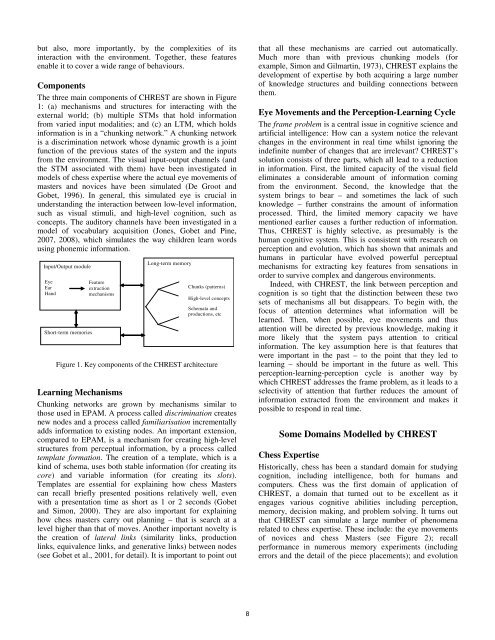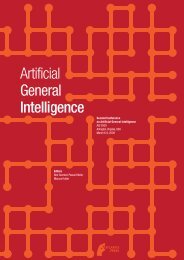Advances in Intelligent Systems Research - of Marcus Hutter
Advances in Intelligent Systems Research - of Marcus Hutter
Advances in Intelligent Systems Research - of Marcus Hutter
You also want an ePaper? Increase the reach of your titles
YUMPU automatically turns print PDFs into web optimized ePapers that Google loves.
ut also, more importantly, by the complexities <strong>of</strong> its<br />
<strong>in</strong>teraction with the environment. Together, these features<br />
enable it to cover a wide range <strong>of</strong> behaviours.<br />
Components<br />
The three ma<strong>in</strong> components <strong>of</strong> CHREST are shown <strong>in</strong> Figure<br />
1: (a) mechanisms and structures for <strong>in</strong>teract<strong>in</strong>g with the<br />
external world; (b) multiple STMs that hold <strong>in</strong>formation<br />
from varied <strong>in</strong>put modalities; and (c) an LTM, which holds<br />
<strong>in</strong>formation is <strong>in</strong> a “chunk<strong>in</strong>g network.” A chunk<strong>in</strong>g network<br />
is a discrim<strong>in</strong>ation network whose dynamic growth is a jo<strong>in</strong>t<br />
function <strong>of</strong> the previous states <strong>of</strong> the system and the <strong>in</strong>puts<br />
from the environment. The visual <strong>in</strong>put-output channels (and<br />
the STM associated with them) have been <strong>in</strong>vestigated <strong>in</strong><br />
models <strong>of</strong> chess expertise where the actual eye movements <strong>of</strong><br />
masters and novices have been simulated (De Groot and<br />
Gobet, 1996). In general, this simulated eye is crucial <strong>in</strong><br />
understand<strong>in</strong>g the <strong>in</strong>teraction between low-level <strong>in</strong>formation,<br />
such as visual stimuli, and high-level cognition, such as<br />
concepts. The auditory channels have been <strong>in</strong>vestigated <strong>in</strong> a<br />
model <strong>of</strong> vocabulary acquisition (Jones, Gobet and P<strong>in</strong>e,<br />
2007, 2008), which simulates the way children learn words<br />
us<strong>in</strong>g phonemic <strong>in</strong>formation.<br />
Input/Output module<br />
Eye<br />
Ear<br />
Hand<br />
Short-term memories<br />
Feature<br />
extraction<br />
mechanisms<br />
Long-term memory<br />
Chunks (patterns)<br />
High-level concepts<br />
Schemata and<br />
productions, etc<br />
Figure 1. Key components <strong>of</strong> the CHREST architecture<br />
Learn<strong>in</strong>g Mechanisms<br />
Chunk<strong>in</strong>g networks are grown by mechanisms similar to<br />
those used <strong>in</strong> EPAM. A process called discrim<strong>in</strong>ation creates<br />
new nodes and a process called familiarisation <strong>in</strong>crementally<br />
adds <strong>in</strong>formation to exist<strong>in</strong>g nodes. An important extension,<br />
compared to EPAM, is a mechanism for creat<strong>in</strong>g high-level<br />
structures from perceptual <strong>in</strong>formation, by a process called<br />
template formation. The creation <strong>of</strong> a template, which is a<br />
k<strong>in</strong>d <strong>of</strong> schema, uses both stable <strong>in</strong>formation (for creat<strong>in</strong>g its<br />
core) and variable <strong>in</strong>formation (for creat<strong>in</strong>g its slots).<br />
Templates are essential for expla<strong>in</strong><strong>in</strong>g how chess Masters<br />
can recall briefly presented positions relatively well, even<br />
with a presentation time as short as 1 or 2 seconds (Gobet<br />
and Simon, 2000). They are also important for expla<strong>in</strong><strong>in</strong>g<br />
how chess masters carry out plann<strong>in</strong>g – that is search at a<br />
level higher than that <strong>of</strong> moves. Another important novelty is<br />
the creation <strong>of</strong> lateral l<strong>in</strong>ks (similarity l<strong>in</strong>ks, production<br />
l<strong>in</strong>ks, equivalence l<strong>in</strong>ks, and generative l<strong>in</strong>ks) between nodes<br />
(see Gobet et al., 2001, for detail). It is important to po<strong>in</strong>t out<br />
that all these mechanisms are carried out automatically.<br />
Much more than with previous chunk<strong>in</strong>g models (for<br />
example, Simon and Gilmart<strong>in</strong>, 1973), CHREST expla<strong>in</strong>s the<br />
development <strong>of</strong> expertise by both acquir<strong>in</strong>g a large number<br />
<strong>of</strong> knowledge structures and build<strong>in</strong>g connections between<br />
them.<br />
Eye Movements and the Perception-Learn<strong>in</strong>g Cycle<br />
The frame problem is a central issue <strong>in</strong> cognitive science and<br />
artificial <strong>in</strong>telligence: How can a system notice the relevant<br />
changes <strong>in</strong> the environment <strong>in</strong> real time whilst ignor<strong>in</strong>g the<br />
<strong>in</strong>def<strong>in</strong>ite number <strong>of</strong> changes that are irrelevant? CHREST’s<br />
solution consists <strong>of</strong> three parts, which all lead to a reduction<br />
<strong>in</strong> <strong>in</strong>formation. First, the limited capacity <strong>of</strong> the visual field<br />
elim<strong>in</strong>ates a considerable amount <strong>of</strong> <strong>in</strong>formation com<strong>in</strong>g<br />
from the environment. Second, the knowledge that the<br />
system br<strong>in</strong>gs to bear – and sometimes the lack <strong>of</strong> such<br />
knowledge – further constra<strong>in</strong>s the amount <strong>of</strong> <strong>in</strong>formation<br />
processed. Third, the limited memory capacity we have<br />
mentioned earlier causes a further reduction <strong>of</strong> <strong>in</strong>formation.<br />
Thus, CHREST is highly selective, as presumably is the<br />
human cognitive system. This is consistent with research on<br />
perception and evolution, which has shown that animals and<br />
humans <strong>in</strong> particular have evolved powerful perceptual<br />
mechanisms for extract<strong>in</strong>g key features from sensations <strong>in</strong><br />
order to survive complex and dangerous environments.<br />
Indeed, with CHREST, the l<strong>in</strong>k between perception and<br />
cognition is so tight that the dist<strong>in</strong>ction between these two<br />
sets <strong>of</strong> mechanisms all but disappears. To beg<strong>in</strong> with, the<br />
focus <strong>of</strong> attention determ<strong>in</strong>es what <strong>in</strong>formation will be<br />
learned. Then, when possible, eye movements and thus<br />
attention will be directed by previous knowledge, mak<strong>in</strong>g it<br />
more likely that the system pays attention to critical<br />
<strong>in</strong>formation. The key assumption here is that features that<br />
were important <strong>in</strong> the past – to the po<strong>in</strong>t that they led to<br />
learn<strong>in</strong>g – should be important <strong>in</strong> the future as well. This<br />
perception-learn<strong>in</strong>g-perception cycle is another way by<br />
which CHREST addresses the frame problem, as it leads to a<br />
selectivity <strong>of</strong> attention that further reduces the amount <strong>of</strong><br />
<strong>in</strong>formation extracted from the environment and makes it<br />
possible to respond <strong>in</strong> real time.<br />
Some Doma<strong>in</strong>s Modelled by CHREST<br />
Chess Expertise<br />
Historically, chess has been a standard doma<strong>in</strong> for study<strong>in</strong>g<br />
cognition, <strong>in</strong>clud<strong>in</strong>g <strong>in</strong>telligence, both for humans and<br />
computers. Chess was the first doma<strong>in</strong> <strong>of</strong> application <strong>of</strong><br />
CHREST, a doma<strong>in</strong> that turned out to be excellent as it<br />
engages various cognitive abilities <strong>in</strong>clud<strong>in</strong>g perception,<br />
memory, decision mak<strong>in</strong>g, and problem solv<strong>in</strong>g. It turns out<br />
that CHREST can simulate a large number <strong>of</strong> phenomena<br />
related to chess expertise. These <strong>in</strong>clude: the eye movements<br />
<strong>of</strong> novices and chess Masters (see Figure 2); recall<br />
performance <strong>in</strong> numerous memory experiments (<strong>in</strong>clud<strong>in</strong>g<br />
errors and the detail <strong>of</strong> the piece placements); and evolution<br />
8













